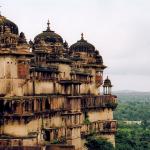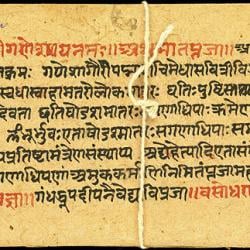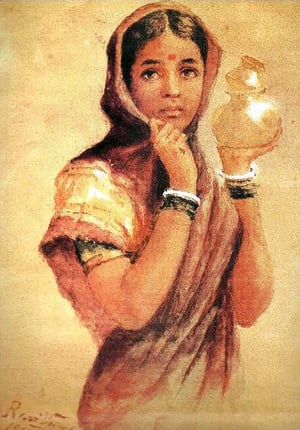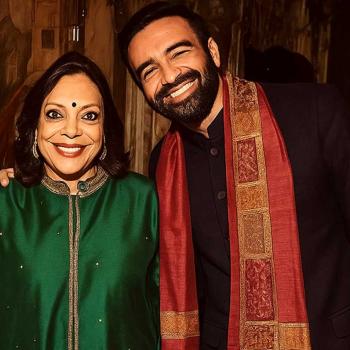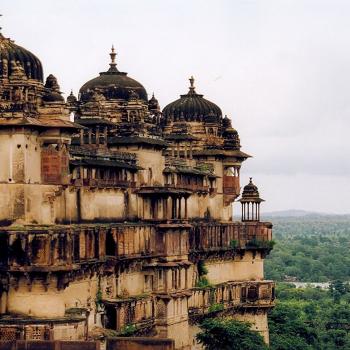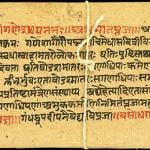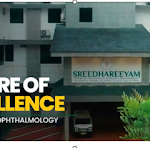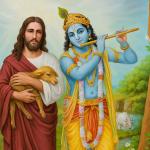About Kashi
Along the river there are over seventy bathing ghats, literally “landings” or “banks,” reaching from Asi Ghat in the south to Adi Keshava in the north, beyond the bridge.
There are two riverside cremation grounds at Harishchandra Ghat and Manikarnika Ghat. Elsewhere in India, the cremation ground is outside of town. Here, the cremation grounds are in the midst of a busy city. Harishchandra Ghat is also known as Adi Manikarnika. They say that this ghat was there before Manikarnika and this was the actual cremation ghat.
The Panchakroshi Road circles the whole kshetra of Kashi. The sacred circle of the city has its center at Madhyameshvara, the “Lord of the Center.” The pilgrims who circumambulate Kashi on this road take five days and visit 108 shrines along the way.
Kapalamochana (“Where the Skull Fell”) Tirtha is the place where it is said Kala Bhairava was freed from the sin of taking of Brahma’s fifth head. When Vishnu and Brahma encountered Shiva as a shaft of light, they both went in opposite directions to find the source. Brahma lied and said he found it. Kala Bhairava then took off his fifth head, which is said to have stuck to his hand, till he reached Kapalamochana Tirtha.
The three main temples: Kashi is said to rest on Shiva’s trident. The three prongs of the trident are at Kashi Vishwanath, Omkareshwar and Kedareshwar temples.
Aumkareshwar Temple: A 1000 years ago, Aumkareshwar was one of the most important Shiva lingas in Kashi. Its grand temple complex stood on the banks of a large inland lake called the Matsyodari Tirtha. That complex has been destroyed. Today, Aumkareshwar is a small temple on a prominent little hillock. It is located in a predominantly Muslim neighbourhood, and is largely not known to pilgrims. The current temple is said to have been built in the 18th century. It is just large enough to contain the linga and one worshipper.
The mystical sound “Aum,” is said to consist of five separate sounds: “A,” “U,” and “M” plus the nasalization (bindu) and the resonance of the sound (nada).
Similarly, the temple of Aumkara is said to consist of five separate shrines, one for each part of this mystical sound. The A-Karaa Temple is today a relatively small and neglected shrine located under a nearby pipal tree. The U-Kara, somewhat larger and more carefully attended, is set within a compound, where the sanctum of the linga, is about three feet below the surface of the earth.
The hilltop temple commonly called Aumkareshvara today is probably on the site of the old Ma-Kara Temple. The other two temples, the Nada Temple and the Bindu Temple have disappeared.
According to the Kashi Khanda, this is the place where Lord Brahma, in ancient times, performed rigorous austerities.
Kashi Vishwanath: Today’s Kashi Vishvanatha Temple was built as recently in the eighteenth century under the patronage of Queen Ahalyabai Holkar of Indore. The history of the previous temples that housed the linga of Vishveshvara is, in a nutshell, the history of Varanasi over the past thousand years: a tale of repeated destruction and desecration. Today, atop the ruins of old Vishveshvara temples, sit two different mosques, one built in the thirteenth century by Razia and one in the seventeenth century by Aurangzeb.
Gnana Vapi: This is one of Kashi’s most famous wells, said to have been dug by Shiva himself in order to cool the linga of Vishveshvara with water. This took place “in the beginning,” when there was no water on earth. The water is said to be a liquid form of jnana, enlightening wisdom. This well of liquid wisdom is said to have been here in Kashi long before Ganga came to earth. On the far side of the well from the temple is the mosque of Aurangzeb, built upon the ruins of the grand sixteenth-century Vishveshvara Temple.
Avimukteshwara Linga: The Puranas say that in ancient days, a linga of Shiva was being pulled along through the night sky by rakshasas. When they were just over the area of Kashi, Shiva thought, “Why shouldn’t they drop me in Avimukta?” Just then the sound of the cock’s crowing arose from the land. When they heard this sound, the rakshasas let go of the linga and flew off in fear of daybreak. Thus was the linga established in Avimukta. It literally dropped out of the sky one day at dawn.
Avimukta is another name of Kashi, meaning “Never Forsaken by Shiva.” The original Avimukteshvara linga is present behind the Gnan Vapi mosque. A newly established linga is also present in a corner of the Kashi Vishwanath temple complex. According to one historian, the current Vishwanath temple complex was actually the Avimukteshvara temple, which was very important till around the twelfth century.
At that time, the Vishwanath linga was located elsewhere, and was burnt down by Qutb-Udin-Aibak (who built the Qutb Minar). A few decades later, the Razia Sultana mosque was built there. After this the Vishwanath linga was moved to the current compound, which was actually the compound of the Avimukteshwara temple. The Avimukteshwara was gradually overshadowed by the Vishwanath linga in popularity.
The relationship of this Avimukteshvara linga to Vishveshvara is made clear in the Kashi Khanda: “Everyone worships Vishveshvara, the ‘Lord of All.’ But Vishveshvara, creator of all, worships Avimukteshvara linga. Even in modern Banaras, Avimukteshvara is sometimes referred to as the guru of Vishveshvara.
Today, however, only a trace of the original linga remains: an ancient fragment of stone hidden amidst three Muslim graves on the north side of the Jnana Vapi Mosque, sprinkled with flowers once a year on the day of Shivaratri. More recently, a new linga of Avimukteshvara has been established in the southeast corner of the present Vishvanatha temple.
Kedara Linga: Kashi’s Kedara is the anchoring temple of the southern sector of the city, called Kedara Khanda. It is one of the most popular and venerable temples of southern Kashi. Unlike Omkara and Vishvanatha, Kedara is a river temple, sitting at the top of an impressive ghat.
Those who live near Kedara claim this as the city’s pre-eminent seat of Shiva. For them, Kedara is the respected elder of Vishveshvara and is the oldest Shiva linga in all Kashi. As one sadhu who lives near the temple put it, “Kedarnatha is the most ancient linga. But Kedarnatha gave his position to Vishvanatha, as the elder brother turns over his position to the younger.”
Vishalakshi Temple: This is a Shakti pitha – where Sati’s eye or earring is said to have fallen. In the sacred geography of Varanasi, six points are said to symbolize Shastanga yoga, which is performing by visiting the six sites. They are the Vishwanath Temple, the Vishalakshi Temple, the Ganga, the Kala Bhairava temple, the Dhundiraj Temple (dedicated to Ganesha) and the Dandapani temple (dedicated to an aspect of Shiva). Vishalakshi temple is in some way said to be matched or paired with the Kala Bhairava temple. Vishalakshi means “wide-eyed”.
Twelve Aditya Temples: As a group, there were twelve Sun temples, said to be protectors of Kashi, circling the city with their light. Many of these had kunds associated with them and are generally in a dilapidated condition. One of the most ancient of these temples is Lolarka Kund, or pool of the Trembling Sun, which is still in a reasonably good condition.
56 Ganeshas: Near the Vishvanatha Temple is a small shrine for Ganesha, called Dhundhiraja or Dhundhi Vinayaka. It is virtually at the center of the mandala of Kashi. Around him, throughout the entire city and far into the countryside, are arrayed fifty-six other Ganeshas in a protective formation. They sit at the eight compass points, spreading out from the center in seven concentric circles.
Bhairavas of Kashi: There are sometimes said to be sixty-four bhairavas, corresponding to the sixty-four yoginis. Eight of the bhairavas are especially counted as leaders: Kapali (“Skull-Bearer”), Asitanga (“Black-Limbs”), Rūrū (“The Dog”), Chanda (“The Fierce”), Krodhana (“Wrath”), Unmatta (“The Wild”), Bhishana (“The Horrific”), and Samhara (“Destruction”).
Kalabhairava & Dandapani: Kalabhairava is known as the kotwal or security officer of Kashi. Kalabhairava is closely related to Dandapani, who is considered the sheriff of Kashi. Both are considered to have great power in the kshetra of Kashi.
Dandapani is the “Club Carrier,” armed with a staff to keep order. This shrine was part of the south side of the Vishwanath temple complex.
Lingas Established by Brahma: Brahma is said to have established two lingas at Dashashvamedha Ghat: Dashashvamedheshvara and Brahmeshvara. There are several other lingas in Varanasi that are also said to have been established by Brahma. Two are near the confluence of the Varana and Ganga Rivers: the Hiranyagarbha linga, named for Brahma as the “Golden Embryo” from which creation began to evolve, and the Sangameshvara linga, which celebrates the joining of the two rivers.
Manikarnika Ghat: Although the name Manikarnika is today most frequently associated with the cremation ground, its oldest and most important association is with the sacred well, called Manikarnika or Chakrapushkarini Kund, the “Discus Lotus-Pool.” This well or tank is said to have been present before Ganga arrived. It is said to have been dug by Vishnu.
The kund was originally a very large lake, and around its banks were the cremation grounds. When Ganga arrived, it is said to have inundated this long lagoon-like lake, leaving only a part of it visible as a spring-fed kund.
The cremation ground is under the professional organization and exclusive supervision of the Doms, an untouchable caste whose dominance here is said to extend far back to when King Harishchandra was purchased in slavery by a Dom to work the cremation grounds.

